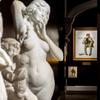Time Across Time: A New Installation from M.S. Rau
- October 10, 2020 15:50
M.S. Rau is pleased to announce the opening of Time Across Time, a curated installation of historic timepieces and artworks that explores humans’ conception of time. The collection seeks to situate humankind’s relationship to time within the technological and historical contexts that so heavily influence our experience of time. A number of different themes will be explored, including the birth of our modern conception of time, how time is inexorably linked to notions of progress, and the inevitability of the passage of time.
Though clocks make up the majority of the collection, the installation itself begins long before the advent of the timepiece as we know it today. Evidence of humans recording the passage of time dates back as far as 20,000 years ago. Prior to the advent of the clock, celestial bodies — the sun, moon, planets and stars — served as the primary reference for measuring the passage of time. The ancient Egyptians developed sundials and obelisks as the first “clocks” to measure the sun’s movement, effectively partitioning the day into morning and afternoon.
The mechanical clock was the great technological invention of the medieval period. Italian city-states were among the pioneers in building elaborate civic clocks housed in campanilli, or bell towers, in town squares. The communal timepieces allowed townspeople to estimate how many hours of daylight remained, allowing them to manage their workdays more easily.
Timepieces intended for private use were far slower to develop, and they were limited to only the most wealthy in society. Time management was a luxury of the elite, and by the Renaissance age, clocks had become a symbol of wealth and power. But for the majority of the population in an overwhelmingly agricultural society, the natural rhythms of the days — the sunrise and the sunset — sufficed.
It wasn’t until the end of the 19th century that timekeeping as we know it today emerged. As agricultural societies became industrial, the issue of time reform and a centralized system of time management surged to the forefront. The complex patchwork of the world’s current local time system made the synchronization of telegraphs, ships and trains nearly impossible. To remedy this, it was decided in 1884 that the world would be divided into 24 distinct zones, each with a mean time determined by the Royal Observatory in Greenwich.
Time was suddenly managed on a global scale. High-precision clocks made it possible to measure time to fractions of a second. The technology is only getting more and more accurate as we continue to attempt to control the one thing we will never have enough of — time.
Time Across Time delves into this history and more through an impressive display of timepieces, fine art and objets d’art that date from the Renaissance to the present day. A selection of clocks forms the heart of the display, including an exceptionally rare Renaissance-age turret clock, a mind-boggling mystery clock by the legendary Cartier, and technologically-advanced time systems by the great Patek Philippe, among many others. Adding depth to the installation are a selection of important objets d’art and fine art related to concepts of time and mortality, such as an important oil on canvas by John Henry Amshewitz and a stunning pair of hardstone obelisks.
The installation is on view in M.S. Rau’s French Quarter gallery from October 16 - November 21. It will also be available to enjoy virtually. Please visit msrau.com for more information.
About M.S. Rau:
M.S. Rau has spent more than 100 years earning the trust of discerning collectors worldwide. Located in the heart of New Orleans’ historic French Quarter, our peerless showroom houses one of the world’s most extensive and stunning collections of museum-quality fine art by artists such as Claude Monet and William Bouguereau, 18th- and 19th-century antiques and breathtaking jewelry, including rare colored diamonds.






100x100_c.jpg)














